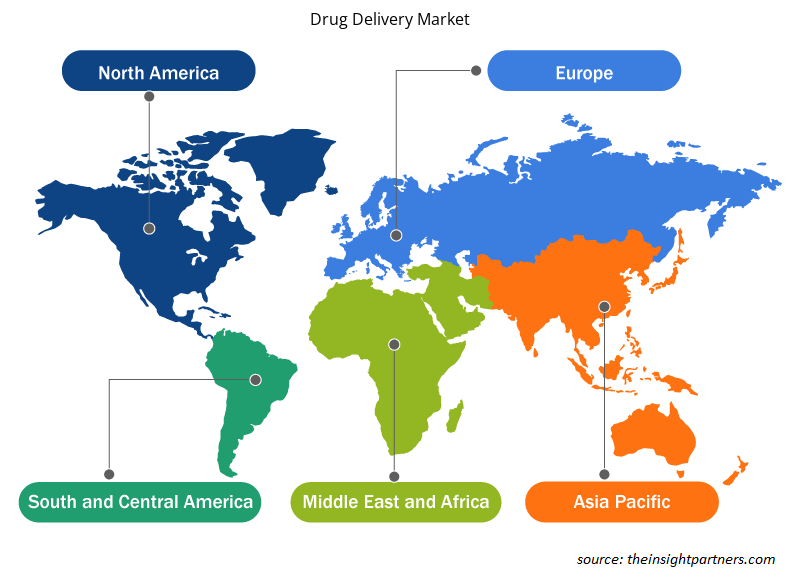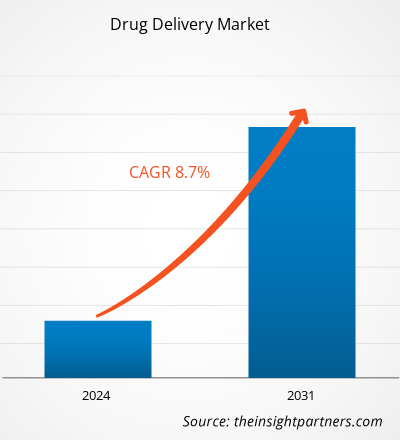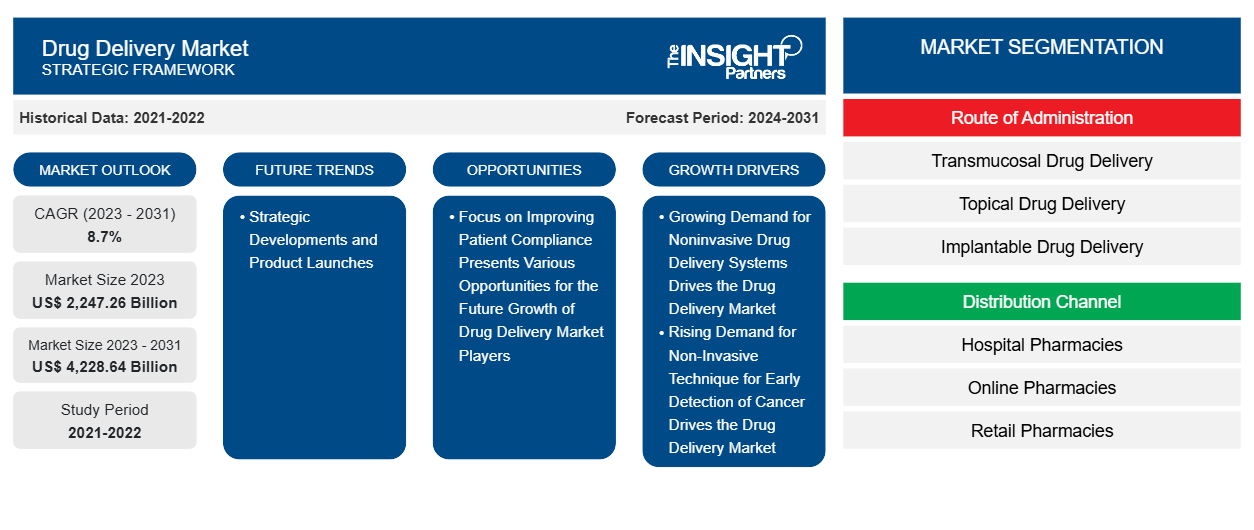Der Markt für Arzneimittelverabreichung wird voraussichtlich von 2.247,26 Milliarden US-Dollar im Jahr 2023 auf 4.228,64 Milliarden US-Dollar im Jahr 2031 anwachsen. Der Markt wird zwischen 2023 und 2031 voraussichtlich eine durchschnittliche jährliche Wachstumsrate (CAGR) von 8,7 % verzeichnen. Strategische Entwicklungen und Produkteinführungen werden voraussichtlich weiterhin die wichtigsten Trends auf dem Markt bleiben.
Marktanalyse für Arzneimittelverabreichung
Chronische Krankheiten neigen dazu, sich mit der Zeit zu verschlimmern und stellen eine erhebliche Belastung für Patienten, ihre Familien und die Gesellschaft dar. Nach Angaben der International Diabetes Federation (IDF) litten 2017 etwa 425 Millionen Menschen an Diabetes, und diese Zahl soll bis 2045 auf 629 Millionen ansteigen. Diabetes ist eine lebensbedrohliche chronische Krankheit, für die es keine spezielle Heilung gibt. Diabetes kann zu zahlreichen Komplikationen in verschiedenen Körperteilen führen und so das Risiko eines vorzeitigen Todes erhöhen. Zu den schwerwiegendsten Komplikationen in Zusammenhang mit Diabetes zählen Nierenversagen, Herzinfarkt, Schlaganfall , Beinamputation, Sehverlust und Nervenschäden. Die Zahl der Diabetesfälle nimmt weltweit erheblich zu.
Die steigende Verbreitung chronischer Krankheiten hat in den letzten Jahrzehnten zu einer verstärkten Forschung und Entwicklung (F&E) im Bereich der Arzneimittelverabreichungssysteme geführt. Die Verwendung eines Arzneimittelverabreichungssystems kann dazu beitragen, die systemischen Nebenwirkungen von Arzneimitteln zu verringern. Es wurden verschiedene Arzneimittelverabreichungssysteme für die gezielte und kontrollierte Verabreichung von Therapeutika für eine Vielzahl chronischer Krankheiten entwickelt, darunter Myokardischämie, Asthma, Lungentuberkulose, Parkinson, Diabetes, Krebs, Arteriosklerose und Alzheimer. Ein geeignetes Arzneimittelverabreichungssystem kann die therapeutische Wirksamkeit eines Arzneimittels verbessern, indem es eine hohe Arzneimittelbioverfügbarkeit über einen längeren Zeitraum gewährleistet. Zielgerichtete Arzneimittelverabreichungssysteme (TDDS) geben Arzneimittel kontrolliert an einer bestimmten Stelle im Körper frei. Auf Nanotechnologie basierende Verabreichungssysteme haben einen erheblichen Einfluss auf die Krebsbehandlung. Zusätzlich zu den Arten der Verabreichungswege bieten nanotherapeutische Arzneimittelverabreichungssysteme (NDDS) mehrere technologische Vorteile, darunter eine längere Arzneimittelzirkulationszeit, eine kontrollierte und anhaltende Arzneimittelfreisetzung, eine verlängerte Halbwertszeit, eine verbesserte Bioverteilung und eine erhöhte intrazelluläre Arzneimittelkonzentration.
Patienten mit chronischen Krankheiten sind auf eine kontinuierliche medikamentöse Behandlung angewiesen, die mit einem ständigen Risiko von Nebenwirkungen verbunden ist. Die Entwicklung wirksamer Verabreichungssysteme für bestimmte Medikamente kann dazu beitragen, die Arzneimittel in den betroffenen Bereichen zu konzentrieren, die Gesamtnebenwirkungen zu minimieren und die Behandlungsergebnisse für die Patienten zu verbessern. Infolgedessen unterstützt die steigende Prävalenz chronischer und lebensstilbedingter Krankheiten die Expansion des Arzneimittelverabreichungsmarktes.
Passen Sie diesen Bericht Ihren Anforderungen an
Sie erhalten kostenlos individuelle Anpassungen an jedem Bericht, einschließlich Teilen dieses Berichts oder einer Analyse auf Länderebene, eines Excel-Datenpakets sowie tolle Angebote und Rabatte für Start-ups und Universitäten.
-
Holen Sie sich die wichtigsten Markttrends aus diesem Bericht.Dieses KOSTENLOSE Beispiel umfasst eine Datenanalyse von Markttrends bis hin zu Schätzungen und Prognosen.
Marktübersicht für Arzneimittelverabreichung
Zu den wichtigsten Wachstumsfaktoren auf dem Markt für Arzneimittelverabreichung gehören die steigende Nachfrage nach nicht-invasiven Arzneimittelverabreichungssystemen, steigende F&E-Ausgaben in Pharmaunternehmen und die steigende Zahl chronischer Krankheiten. Allerdings behindern die hohen Kosten im Zusammenhang mit der Entwicklung von Arzneimitteln und Verabreichungssystemen sowie Produktrückrufe bei Arzneimittelverabreichungssystemen das Marktwachstum.
Treiber und Chancen auf dem Arzneimittelverabreichungsmarkt
Steigende F&E-Ausgaben in Pharmaunternehmen begünstigen den Markt
F&E ist ein wesentlicher Bestandteil des Geschäfts eines jeden Unternehmens. Laut einer Studie „Total Global Pharmaceutical R&D Spending 2014–2028“ von Matej Mikulic beliefen sich die Ausgaben für F&E in der globalen Pharmaindustrie im Jahr 2021 auf ~238 Milliarden US-Dollar. Im Vergleich zu anderen Branchen sind Pharmaunternehmen stärker von der Notwendigkeit getrieben, innovative Produkte zu entwickeln und erhebliche Investitionen in F&E zu tätigen. Dies liegt vor allem am zeitlich begrenzten Patentschutz von Arzneimitteln und der daraus resultierenden Gefahr eines Umsatzeinbruchs aufgrund der Konkurrenz durch Generika und Biosimilars. Pharma- und Medizintechnikunternehmen konzentrieren sich auf F&E, um neue Moleküle für verschiedene therapeutische Anwendungen mit dem größten medizinischen und kommerziellen Potenzial einzuführen. Starke F&E-Kapazitäten helfen ihnen auch, qualitativ hochwertige und innovative Produkte auf den Markt zu bringen. Die F&E-Ausgaben von Biopharmaunternehmen sind im Laufe der Jahre ebenfalls gestiegen.
Laut einer Studie „Global Trends in R&D 2022“ von IQVIA wurden im Jahr 2021 weltweit 84 neuartige Wirkstoffe (NAS) auf den Markt gebracht, was die Gesamtzahl der Markteinführungen in den letzten 20 Jahren auf 883 erhöht. Die USA sind nach wie vor das Land mit den frühesten und höchsten Markteinführungszahlen. 44 (über 60 %) der 72 im Jahr 2021 weltweit auf den Markt gebrachten NAS wurden von der FDA als First-in-Class-Medikamente zugelassen, und 40 (mehr als 50 %) erhielten den Orphan-Drug-Status, was auf ihre Verwendung zur Behandlung seltener Krankheiten hinweist. Risikokapitalgeschäfte und Investitionsströme in den USA haben in den letzten zwei Jahren aufgrund des hohen Interesses an den Biowissenschaften zugenommen. Das Land verzeichnete im Jahr 2021 über 2.000 Abschlüsse mit einem Transaktionswert von 47 Milliarden US-Dollar. Darüber hinaus gaben die 15 größten Pharmaunternehmen im Jahr 2021 133 Milliarden US-Dollar für Forschung und Entwicklung aus, ein Anstieg von 44 % seit 2016.
Strategische Entwicklungen und Produkteinführungen
Unternehmen, die auf dem Arzneimittelverabreichungsmarkt tätig sind, konzentrieren sich ständig auf strategische Entwicklungen wie Kooperationen, Partnerschaften, Vereinbarungen und die Einführung neuer Produkte, die ihnen helfen, ihren Umsatz zu steigern. Die Einführung neuer Produkte zielt hauptsächlich auf erhöhte Sicherheit, benutzerfreundliche Funktionen, bessere Dosierungsmöglichkeiten usw. ab, um einen großen Patientenstamm anzuziehen. Durch verbesserte Dosierungsmöglichkeiten ergänzen Arzneimittelverabreichungssysteme die therapeutischen Ergebnisse und erhöhen das Potenzial des Krankheitsmanagements in der häuslichen Pflege. Einige der bemerkenswerten Entwicklungen auf dem Arzneimittelverabreichungsmarkt sind unten aufgeführt.
• Im Juni 2022 brachte Esteve Pharmaceuticals GmbH INBRIJA 33 mg (Levodopa-Inhalationspulver in Hartkapseln) in Deutschland auf den Markt. INBRIJA ist in der EU zur intermittierenden Behandlung episodischer motorischer Fluktuationen bei Erwachsenen mit Parkinson-Krankheit indiziert und wird zusammen mit einem Levodopa/Dopa-Decarboxylase-Hemmer verschrieben.
• Im Juni 2022 haben EVERSANA und Accord BioPharma eine Partnerschaft geschlossen, um die Markteinführung der 42 mg Injektionsemulsion CAMCEVI (Leuprolid) zur Behandlung von fortgeschrittenem Prostatakrebs bei Erwachsenen zu unterstützen.
• Im März 2023 arbeitete die Stevanato Group mit Recipharm zusammen, um vorfüllbare Spritzen zu entwickeln und herzustellen, die in einen neuen Soft-Mist-Inhalator zum Inhalieren empfindlicher biologischer Produkte integriert werden sollen. Die neue strategische Zusammenarbeit zielt darauf ab, pharmazeutischen und biopharmazeutischen Unternehmen, die die proprietären Soft-Mist-Inhalatoren von Recipharm verwenden, innovative Primärverpackungen bereitzustellen.
Die steigende Zahl solcher strategischer Entwicklungen und Produkteinführungen dürfte in den kommenden Jahren zu neuen Wachstumstrends auf dem Markt für Arzneimittelverabreichungen führen.
Segmentierungsanalyse des Arzneimittelverabreichungsmarktberichts
Wichtige Segmente, die zur Ableitung der Marktanalyse für Arzneimittelverabreichung beigetragen haben, sind Verabreichungsweg, Vertriebskanal und Endverbraucher.
- Basierend auf der Verabreichungsmethode ist der Markt für Arzneimittelverabreichung in transmukosale Arzneimittelverabreichung, topische Arzneimittelverabreichung, implantierbare Arzneimittelverabreichung, injizierbare Arzneimittelverabreichung, orale Arzneimittelverabreichung und okuläre Arzneimittelverabreichung unterteilt. Das Segment der injizierbaren Arzneimittelverabreichung ist weiter unterteilt in herkömmliche Injektionsgeräte und fortschrittliche Geräte. Das Segment der oralen Arzneimittelverabreichung ist weiter unterteilt in feste orale Arzneimittel, flüssige orale Arzneimittel und halbfeste orale Arzneimittel. Das Segment der topischen Arzneimittelverabreichung ist weiter unterteilt in halbfeste topische Arzneimittelverabreichung, flüssige topische Arzneimittelverabreichungsformulierungen, feste topische Arzneimittelverabreichungsformulierungen und transdermale Arzneimittelverabreichung. Die transmukosale Arzneimittelverabreichung ist weiter unterteilt in pulmonale und nasale Arzneimittelverabreichung, bukkale und sublinguale Arzneimittelverabreichung, rektale transmukosale Arzneimittelverabreichung und vaginale transmukosale Arzneimittelverabreichung. Die okuläre Arzneimittelverabreichung ist weiter unterteilt in Augentropfen und -sprays, Gele und Salben, okuläre Einsätze und Punctum Plugs sowie therapeutische Kontaktlinsen. Das Segment der injizierbaren Arzneimittelverabreichung hatte 2023 den größten Marktanteil.
- Nach Vertriebskanal ist der Markt in Einzelhandelsapotheken, Krankenhausapotheken und Online-Apotheken segmentiert. Das Segment der Krankenhausapotheken hatte im Jahr 2023 den größten Marktanteil.
- In Bezug auf den Endverbraucher ist der Markt in häusliche Pflegeeinrichtungen, Krankenhäuser und Kliniken sowie andere Endverbraucher segmentiert. Das Segment Krankenhäuser und Kliniken hielt im Jahr 2023 einen erheblichen Marktanteil.
Marktanteilsanalyse für Arzneimittelverabreichung nach geografischer Lage
Der geografische Umfang des Berichts zum Markt für Arzneimittelverabreichungsformen ist hauptsächlich in fünf Regionen unterteilt: Nordamerika, Naher Osten und Afrika, Asien-Pazifik, Europa sowie Süd- und Mittelamerika.
Nordamerika dominiert den Markt. Laut Angaben der Centers for Disease Control and Prevention (CDC) litten im Jahr 2022 in den USA fast 37,3 Millionen Menschen an Diabetes. Etwa 3,75 % dieser Gesamtzahl waren Typ-1-Diabetes, was etwa 1,45 Millionen Menschen entspricht. Infolgedessen wird erwartet, dass die wachsende Diabetikerpopulation im Land die Nachfrage nach unterschiedlichen Arzneimittelverabreichungssystemen zur Behandlung von Diabetespatienten ankurbelt.
Regionale Einblicke in den Arzneimittelverabreichungsmarkt
Die regionalen Trends und Faktoren, die den Arzneimittelverabreichungsmarkt im Prognosezeitraum beeinflussen, wurden von den Analysten von Insight Partners ausführlich erläutert. In diesem Abschnitt werden auch die Marktsegmente und die Geografie des Arzneimittelverabreichungsmarkts in Nordamerika, Europa, im asiatisch-pazifischen Raum, im Nahen Osten und Afrika sowie in Süd- und Mittelamerika erörtert.

- Erhalten Sie regionale Daten zum Arzneimittelverabreichungsmarkt
Umfang des Marktberichts zur Arzneimittelverabreichung
| Berichtsattribut | Details |
|---|---|
| Marktgröße im Jahr 2023 | 2.247,26 Milliarden US-Dollar |
| Marktgröße bis 2031 | 4.228,64 Milliarden US-Dollar |
| Globale CAGR (2023 - 2031) | 8,7 % |
| Historische Daten | 2021-2022 |
| Prognosezeitraum | 2024–2031 |
| Abgedeckte Segmente |
Nach Verabreichungsweg
|
| Abgedeckte Regionen und Länder |
Nordamerika
|
| Marktführer und wichtige Unternehmensprofile |
|
Dichte der Akteure auf dem Arzneimittelverabreichungsmarkt: Die Auswirkungen auf die Geschäftsdynamik verstehen
Der Markt für Arzneimittelverabreichung wächst rasant, angetrieben durch die steigende Nachfrage der Endverbraucher aufgrund von Faktoren wie sich entwickelnden Verbraucherpräferenzen, technologischen Fortschritten und einem größeren Bewusstsein für die Vorteile des Produkts. Mit steigender Nachfrage erweitern Unternehmen ihr Angebot, entwickeln Innovationen, um die Bedürfnisse der Verbraucher zu erfüllen, und nutzen neue Trends, was das Marktwachstum weiter ankurbelt.
Die Marktteilnehmerdichte bezieht sich auf die Verteilung der Firmen oder Unternehmen, die in einem bestimmten Markt oder einer bestimmten Branche tätig sind. Sie gibt an, wie viele Wettbewerber (Marktteilnehmer) in einem bestimmten Marktraum im Verhältnis zu seiner Größe oder seinem gesamten Marktwert präsent sind.
Die wichtigsten auf dem Arzneimittelverabreichungsmarkt tätigen Unternehmen sind:
- Pfizer Inc,
- Johnson & Johnson,
- Becton Dickinson und Co,
- Novo Nordisk AS,
- Boston Scientific Corp.,
- Baxter International Inc,
Haftungsausschluss : Die oben aufgeführten Unternehmen sind nicht in einer bestimmten Reihenfolge aufgeführt.

- Überblick über die wichtigsten Akteure auf dem Arzneimittelverabreichungsmarkt
Neuigkeiten und aktuelle Entwicklungen auf dem Arzneimittelverabreichungsmarkt
Der Markt für Arzneimittelverabreichung wird durch die Erhebung qualitativer und quantitativer Daten nach Primär- und Sekundärforschung bewertet, die wichtige Unternehmensveröffentlichungen, Verbandsdaten und Datenbanken umfasst. Nachfolgend sind einige der Entwicklungen auf dem Markt für Arzneimittelverabreichung aufgeführt:
- Johnson & Johnson gab Robert Langer, Sc.D., vom Massachusetts Institute of Technology (MIT) als Gewinner des Dr. Paul Janssen Award 2023 für biomedizinische Forschung bekannt. Dr. Langer wurde für seine bahnbrechende Arbeit bei der Entwicklung neuartiger Arzneimittelverabreichungssysteme geehrt, die Medikamente über längere Zeiträume kontinuierlich, präzise und in kontrollierten Mengen abgeben können. Seine bahnbrechende Forschung zu biomedizinischen Verbindungen für die Arzneimittelverabreichung hat Auswirkungen auf eine breite Palette medizinischer Technologien, darunter Krebstherapie, Impfstoffentwicklung, Gentherapie und mehr. (Quelle: Johnson & Johnson, Newsletter, Februar 2024)
- Aptar Pharma, Teil der AptarGroup, Inc. (NYSE: ATR), ein weltweit führendes Unternehmen für Arzneimittelverabreichungssysteme, -dienstleistungen und aktive Materialwissenschaftslösungen, gibt heute die Markteinführung von APF Futurity bekannt, seiner ersten metallfreien Mehrdosen-Nasenspraypumpe, die für die Verabreichung von Nasensalzlösungen und anderen vergleichbaren rezeptfreien (OTC) Formulierungen entwickelt wurde. (Quelle: Aptar Pharma, Pressemitteilung, Januar 2024)
Marktbericht zur Arzneimittelverabreichung – Umfang und Ergebnisse
Der Bericht „Marktgröße und Prognose für Arzneimittelverabreichungsanlagen (2021–2031)“ bietet eine detaillierte Analyse des Marktes, die die folgenden Bereiche abdeckt:
- Größe und Prognose des Arzneimittelverabreichungsmarktes auf globaler, regionaler und Länderebene für alle wichtigen Marktsegmente, die im Rahmen des Berichts abgedeckt sind
- Markttrends und Marktdynamiken im Bereich der Arzneimittelverabreichung wie Treiber, Einschränkungen und wichtige Chancen
- Detaillierte PEST/Porters Five Forces- und SWOT-Analyse
- Marktanalyse für Arzneimittelverabreichung, die wichtige Markttrends, globale und regionale Rahmenbedingungen, wichtige Akteure, Vorschriften und aktuelle Marktentwicklungen umfasst
- Branchenlandschaft und Wettbewerbsanalyse, einschließlich Marktkonzentration, Heatmap-Analyse, prominenten Akteuren und aktuellen Entwicklungen auf dem Markt für Arzneimittelverabreichung
- Detaillierte Firmenprofile
- Historische Analyse (2 Jahre), Basisjahr, Prognose (7 Jahre) mit CAGR
- PEST- und SWOT-Analyse
- Marktgröße Wert/Volumen – Global, Regional, Land
- Branchen- und Wettbewerbslandschaft
- Excel-Datensatz
Aktuelle Berichte
Verwandte Berichte
Erfahrungsberichte
Grund zum Kauf
- Fundierte Entscheidungsfindung
- Marktdynamik verstehen
- Wettbewerbsanalyse
- Kundeneinblicke
- Marktprognosen
- Risikominimierung
- Strategische Planung
- Investitionsbegründung
- Identifizierung neuer Märkte
- Verbesserung von Marketingstrategien
- Steigerung der Betriebseffizienz
- Anpassung an regulatorische Trends























 Kostenlose Probe anfordern für - Markt für Arzneimittelverabreichung
Kostenlose Probe anfordern für - Markt für Arzneimittelverabreichung